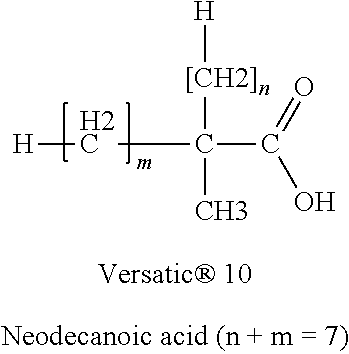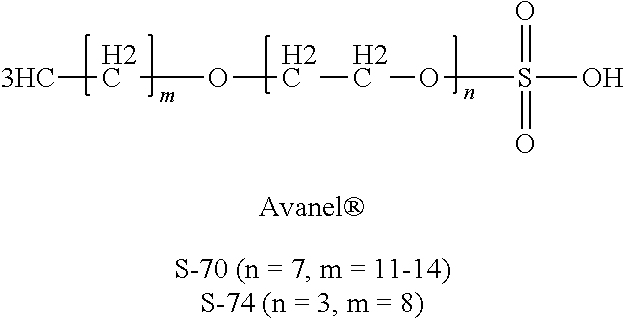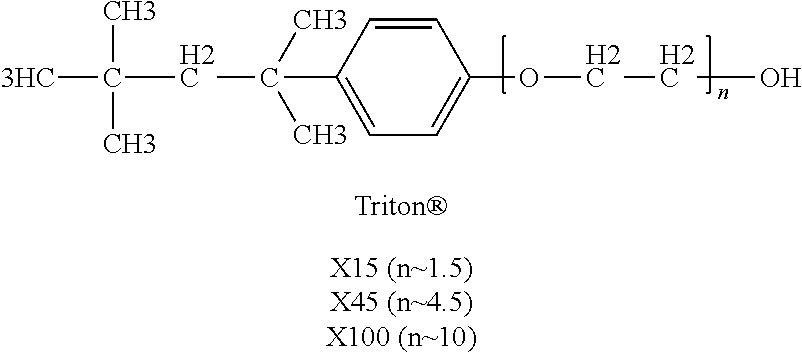Fluoropolymer resin treatment employing heating and oxygen source to reduce discoloration
a technology which is applied in the field of can solve the problems of fluoropolymer resin thermal discoloration, undesirable color formation or increase, and undesirable gray or brown color, etc., and achieve the effect of reducing thermal discoloration of fluoropolymer resin and thermal discoloration reduction of fluoropolymer resin
- Summary
- Abstract
- Description
- Claims
- Application Information
AI Technical Summary
Benefits of technology
Problems solved by technology
Method used
Image
Examples
example 1
Heating of FEP Below the Melting Point
[0106]Aqueous FEP 1 dispersion polymerized as described above is coagulated in a heated glass reactor. 1250 ml of dispersion is heated to 85° C. in a water bath and then transferred to a 2,000 ml jacketed glass reactor with four internal baffles produced by Lab Glass of Vineland, N.J. where the temperature is maintained at 85° C. by circulating heated water through the jacket. Two high shear impellers are turned at 2,470 rpm for 3600 seconds to cause the dispersion to separate into a polymer phase and a water phase. The contents are filtered through 150 micron mesh filter bag model NMO150P1SHS manufactured by The Strainrite Companies of Auburn, Me. The polymer is dried for 40 hours in a circulating air oven set at 150° C. to produce a dry powder.
[0107]A sample of dried powder is molded to produce color films as described in the Test Methods section above as Measurement of Thermally Induced Discoloration for melt-processible fluoropolymers to est...
example 2
Heating of FEP Above the Melting Point
[0110]Aqueous FEP-2 dispersion polymerized as described above is coagulated by freezing the dispersion in a 20 liter Cubitainer® produced by Hedwin Corporation of Baltimore, Md. The Cubitainer® is placed in a So-Low model CH25-13 freezer manufactured by Environmental Equipment of Cincinnati, Ohio that is maintained at −30° C. and frozen for 40 hours. The Cubitainer® is then removed and allowed to thaw for 40 hours. The contents are filtered through a 150 micron mesh filter bag model NMO150P1SHS manufactured by The Strainrite Companies of Auburn, Me. The solids are dried for 40 hours in a circulating air oven set at 150° C. to produce a dry powder.
[0111]A sample of dried powder is molded to produce color films as described in the Test Methods section above as Measurement of Thermally Induced Discoloration for melt-processible fluoropolymers to establish the base value of L* (L*i=35.6) for untreated color which value is more than 44 L units below ...
example 3
FEP Dried Using Dynamic Drying
[0114]Aqueous FEP-3 dispersion polymerized as described above is diluted to 5 weight percent solids with deionized water. The dispersion is coagulated by freezing the dispersion at −30° C. for 16 hours. The dispersion is thawed and the water is separated from the solids by filtering through a 150 micron mesh filter bag model NMO150P1SHS manufactured by The Strainrite Companies of Auburn, Me.
[0115]A portion of the solids is dried for 40 hours in a circulating air oven set at 150° C. to produce a dry powder. The dried powder is molded to produce color films as described in Test Methods Measurement of Thermally Induced Discoloration for Melt-Processible Fluoropolymers. Resulting value for L*i is 25.9, indicating discoloration of the polymer upon thermal processing of untreated polymer. Measurements are shown in Table 3.
[0116]Another portion of the solids is dried by evenly distributing 18 grams dry weight of polymer on an 8 inch (20.32 cm) diameter PEEK fa...
PUM
| Property | Measurement | Unit |
|---|---|---|
| temperature | aaaaa | aaaaa |
| temperature | aaaaa | aaaaa |
| melt viscosity | aaaaa | aaaaa |
Abstract
Description
Claims
Application Information
 Login to View More
Login to View More - R&D
- Intellectual Property
- Life Sciences
- Materials
- Tech Scout
- Unparalleled Data Quality
- Higher Quality Content
- 60% Fewer Hallucinations
Browse by: Latest US Patents, China's latest patents, Technical Efficacy Thesaurus, Application Domain, Technology Topic, Popular Technical Reports.
© 2025 PatSnap. All rights reserved.Legal|Privacy policy|Modern Slavery Act Transparency Statement|Sitemap|About US| Contact US: help@patsnap.com



